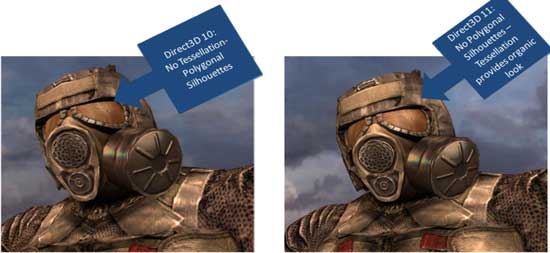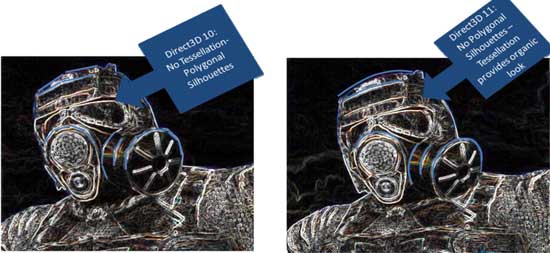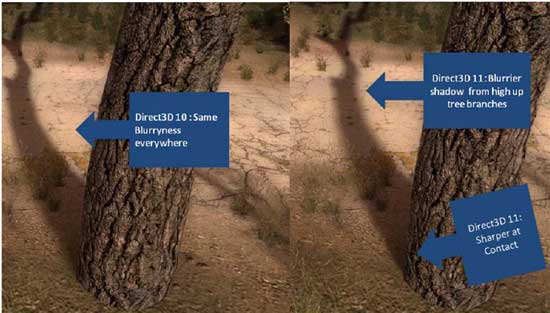The Radeon HD 5970: Completing AMD's Takeover of the High End GPU Market
by Ryan Smith on November 18, 2009 12:00 AM EST- Posted in
- GPUs
STALKER: Call of Pripyat – A Peak at More DX11
For the 5970 launch, AMD sent over a special benchmark version of STALKER: Call of Pripyat, which has since then been made public at the GSC Game World STALKER website. STALKER is another one of AMD’s big DX11 titles, as it’s technically the 2nd DX11 title to launch and the first such title to implement most of the major DX11 features. The Russian version actually shipped back in October, and the German version shipped 2 weeks ago. However we’re told that these versions only had an early-stage implementation of the DX11 feature set, and that the demo is more representative of where the game is after patching and what it will be like when it finally launches in the rest of the world early next year.
Since it’s an unplayable demo, we’re going to forgo any competitive benchmarking (it’s not as if anyone else has a DX11 card anyhow) but we will look quickly at the performance impact of these features, since this is the closest thing we have to a playable game using them at this point in time.
STALKER makes use of 3 major DX11 features.
- High Definition Ambient Occlusion using compute shaders
- Tessellation
- Contact hardening shadows
We’ve already seen HDAO with Battleforge, and it’s no different here in STALKER. And we’ve covered tessellation in-depth in our look at DirectX 11.
So today, let’s talk about contact hardening shadows. Shadowing has been on a path of particularly noticeable evolution. The first real shadows, seen in such titles as Doom 3, had very hard edges. Stencil buffering was used to determine where a shadow would fall, and that was it. Diffusion was never taken into account. Newer games have since taken diffusion into account to generate soft shadows, but these shadows aren’t necessarily accurate. Currently soft shadows are implemented with a fixed degree of softness around the entire shadow, which isn’t how shadows really work.
With diffusion, the softness of a shadow increases with the distance of the casting object from the surface the shadow is being displayed on. AMD loves to use a light pole as an example, as the top of the shadow should be softer than the bottom. These shadows are referred to as contact hardening shadows, and the use of them in games has been limited by the expense of calculating them using the DX10 feature set. STALKER allows for contact hardening shadows with DX10.1 and DX11 mode.
Unfortunately a moving benchmark makes for a poor source to take screenshots, so we’re going to stick with AMD’s reference shots here. Only contact hardening shadows are particularly noticeable in the benchmark; tessellation and HDAO are there, but are virtually impossible to catch given the zoomed-out nature of the benchmark and the fact that it’s constantly in motion.
The benchmark comes with 4 different flybys, each under different environmental conditions: day, night, day with rain, and day with sun shafts. We’ve gone ahead and benchmarked the game during the “day” flyby, once with the DX11 feature set enabled, and once with it disabled. This means for DX11 mode tessellation, contact hardening shadows, and Ultra HDAO were enabled; and for DX10 tessellation and contact hardening shadows were disabled, and High HDAO was used.
| STALKER: Call of Pripyat, Day Benchmark | DX10 | DX11 |
| Average FPS | 31.4 | 35.1 |
| Minimum FPS | 17.7 | 21.2 |
Enabling all of these features actually causes performance to rise, thanks to the more efficient implementation of HDAO as a compute shader as opposed to a pixel shader. Ultimately what this means is that unless HDAO is disabled entirely, STALKER is going to be faster on a DX11 card running the entire DX11 feature set than it will be when running the DX10 feature set.
The biggest performance hit, and the reason we’re not breaking 40fps here even with a 5970, is due to how anti-aliasing is implemented in STALKER. As it uses deferred rendering, the game does its own anti-aliasing. We used 4X MSAA here along with per-pixel alpha transparency testing (basically Adaptive/Transparancy AA). Disabling anti-aliasing improves performance dramatically.













114 Comments
View All Comments
prophet001 - Wednesday, November 18, 2009 - link
This looks like a sweet card. Certainly ATI is taking control of the market.One question though...
What happened to the Hydra by Lucid Logix? I haven't heard anything about it in a while. Theoretically, the Hydra should take 2 ATI cards and make them perform better than Crossfire can.
Any news?
tamalero - Wednesday, November 18, 2009 - link
there as been reviews of HYDRA already, what planet are you on?GeorgeH - Wednesday, November 18, 2009 - link
1) No need to be a douche.2) No Hydra 200 products have shipped, all current "reviews" have been done using Lucid's development hardware.
3) It appears that Hydra will not work well with dual GPU cards; it will see only one of the GPUs.
4) Early results show that Hydra offers roughly equal performance overall to Crossfire/SLI.
5) Link to one of the better articles I've read:
http://www.pcper.com/article.php?aid=815">http://www.pcper.com/article.php?aid=815
driver01z - Wednesday, November 18, 2009 - link
Wow - so we have a card now that plays the latest Crysis at 2560*1600, 4XAA with details at a smooth playable FPS. IMHO I believe we've entered a new GPU generation. Or new compared to the capabilities I'm used to.rcpratt - Wednesday, November 18, 2009 - link
Is there some way to set up a dual-monitor setup (2 x 1920x1080) to run in horizontal span mode (3840 x 1080), like you do with your three monitors, without an Eyefinity card? I'm currently running with a 4870 and haven't been able to find a way to do this.The0ne - Wednesday, November 18, 2009 - link
I haven't tried but you should be able to do this easily, using catalyst. There's an option there to flip your screens for horizontal/vertical views and duplicate/extend your screens. That should do it for you.I haven't use the flip feature but I use the extend all the time because I'm hooked up to my tv.
rcpratt - Wednesday, November 18, 2009 - link
I've spent hours trying to find a way to do it with Catalyst, and I can't find one. Right now it's on extend, which just leaves the secondary monitor as the desktop, with no taskbar on the bottom, and leaves me unable to play games at 3840x1080.If anybody has an explanation or idea, I'd appreciate it.
Spoelie - Thursday, November 19, 2009 - link
To put it simple, no it's not supported. The only way you'll be able to use the second screen is with games that are explicitly coded to support dual screens (Supreme Commander?).Your only other option is to use a Matrox multimon device (forgot the name) or an EyeFinity card of course. No NVIDIA card will allow this either, it's not a driver issue.
Either way, 2 screens wouldn't be a nice experience anyway, with the big bezel right in the middle, I can't imagine any type of game where that would work (no FPS, RTS, RPG, racing game, ...)
rcpratt - Thursday, November 19, 2009 - link
That's what I was afraid of. Thanks. And yeah, I wasn't planning on playing with 2 monitors, but I was considering getting a third. Oh well, probably better that I can't blow the cash :)The0ne - Wednesday, November 18, 2009 - link
On the same topic, does anyone know why my dual screen setup resets after PC restarts/shutdowns? In addition, I HAVE to select duplicate first, set it and then switch to extend. Selecting extend first doesn't enable it. Using current driver but this was there with previous versions as well.I've Googled and read many forums but haven't encountered many users having this particular issue. This is consistent in XP, Vista and Win7 as far as I can remember.
4870 with Dell 30" and Samsumg 73" 1080P TV. Temperatures around 56C for video card. If you have any tips I appreciate them. Thanks in advance.